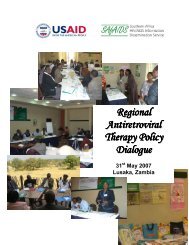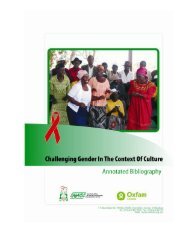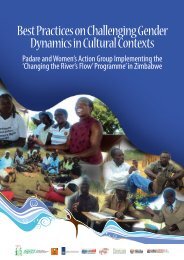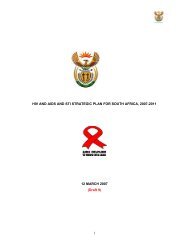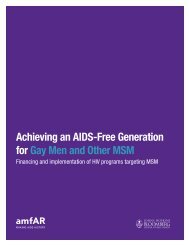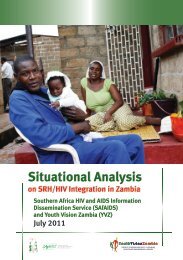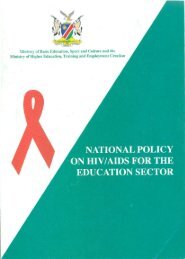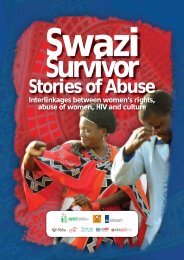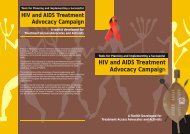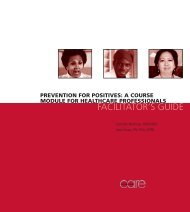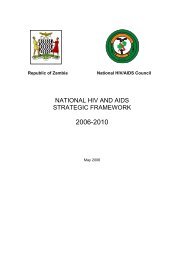Implementation of regional and international HIV prevention - SAfAIDS
Implementation of regional and international HIV prevention - SAfAIDS
Implementation of regional and international HIV prevention - SAfAIDS
- No tags were found...
Create successful ePaper yourself
Turn your PDF publications into a flip-book with our unique Google optimized e-Paper software.
Adoption <strong>of</strong> a multi-sectoral response in the two countries to ensure that all sectors <strong>of</strong> societyare actively involved in the design, implementation, review, monitoring <strong>and</strong> evaluation <strong>of</strong>the national response to <strong>HIV</strong>/AIDS is in line with UNGASS (2001), the Abuja Declaration (2001)<strong>and</strong> the Maseru Declaration (2003). Article 37 <strong>of</strong> UNGASS calls for governments to ensure thedevelopment <strong>and</strong> implementation <strong>of</strong> multi-sectoral national strategies <strong>and</strong> financing plans forcombating <strong>HIV</strong>/AIDS. Abuja Declaration article 26, calls for Governments to “make available thenecessary resources for the improvement <strong>of</strong> the comprehensive multi-sectoral response” <strong>and</strong>articles 1(a) <strong>and</strong> 3 (e) <strong>of</strong> the Maseru Declaration also exhort SADC countries to implement multisectoralismin their <strong>HIV</strong> <strong>and</strong> AIDS national response.The provision <strong>of</strong> <strong>HIV</strong> <strong>prevention</strong>, care <strong>and</strong> support services in both countries is also guidedby their commitment to <strong>international</strong> instruments, particularly UNGASS, the MillenniumDevelopment Goals (MDGs), the Abuja Declaration <strong>and</strong> the WHO <strong>HIV</strong> <strong>and</strong> AIDS Plan 2004-2005.UNGASS makes provisions for the development <strong>and</strong> implementation <strong>of</strong> multi-sectoral nationalstrategies for combating <strong>HIV</strong> <strong>and</strong> AIDS, which includes addressing risk, vulnerability, <strong>prevention</strong>,care, treatment <strong>and</strong> support for those affected by the <strong>HIV</strong> epidemic. The MDG goal numbersix seeks to combat <strong>HIV</strong> <strong>and</strong> AIDS <strong>and</strong> other diseases through increased use <strong>of</strong> condoms <strong>and</strong>behavioural change. The goal also sets a target for the universal access to treatment for <strong>HIV</strong><strong>and</strong> AIDS for all those who need it through the use <strong>of</strong> ARVs.The two countries have adopted UNAIDS’s three ones principle (one strategy, co-ordinatingauthority, <strong>and</strong> monitoring <strong>and</strong> evaluation framework) evidenced by their countries’commitment to having one agreed upon AIDS action framework (NSP), one national coordinatingauthority (NERCHA for Swazil<strong>and</strong> <strong>and</strong> NAC for Zambia) <strong>and</strong> one monitoring <strong>and</strong>evaluation framework (SHAPMoS for Swazil<strong>and</strong> <strong>and</strong> NARF for Zambia).4.3 Analysis <strong>of</strong> legislative <strong>and</strong> policy environmentOn paper, Swazil<strong>and</strong> <strong>and</strong> Zambia’s <strong>HIV</strong> <strong>and</strong> AIDS policies tend to comply with the various<strong>international</strong> <strong>and</strong> <strong>regional</strong> declarations on a number <strong>of</strong> issues such as elimination <strong>of</strong> stigma<strong>and</strong> discrimination against PL<strong>HIV</strong>; gender equality <strong>and</strong> elimination <strong>of</strong> all forms <strong>of</strong> discriminationagainst women; greater involvement <strong>of</strong> PL<strong>HIV</strong>; PMTCT; <strong>prevention</strong> <strong>of</strong> <strong>HIV</strong> infection <strong>and</strong> respectfor human rights <strong>of</strong> PL<strong>HIV</strong>. <strong>HIV</strong> <strong>and</strong> AIDS responses in the two countries also seem to recognisethe conventions <strong>and</strong> declarations they are signatory to.30Certainly, the two countries’ national responses are in line with the Maseru Declaration on<strong>HIV</strong> <strong>and</strong> AIDS adopted by the SADC Summit in 2003 <strong>and</strong> the New Partnership for Africa’sDevelopment (NEPAD) adopted in July 2001. The Maseru Declaration reaffirms SADCgovernments’ commitment to promote <strong>HIV</strong> <strong>prevention</strong>, care <strong>and</strong> support. The Declarationparticularly makes provisions for reinforcing multi-sectoral <strong>prevention</strong> programmes aimed atstrengthening family units <strong>and</strong> upholding appropriate cultural values, positive behaviouralchange <strong>and</strong> promoting responsible sexual behaviour. The Declaration also makes provisionsfor improving care, access to counselling <strong>and</strong> testing services, treatment <strong>and</strong> support byfocusing on strengthening health-care systems, family <strong>and</strong> community-based care; expansion<strong>of</strong> workplace programmes, exp<strong>and</strong>ing access to voluntary counselling <strong>and</strong> testing <strong>and</strong>increasing access to affordable essential medicines, including ARVs <strong>and</strong> related technologies.The NEPAD framework identifies <strong>HIV</strong> <strong>and</strong> AIDS as one <strong>of</strong> the major impediments facing Afric<strong>and</strong>evelopment. The framework makes provisions for strengthening Africa’s participation inprocesses aimed at procuring affordable medicines <strong>and</strong> mobilising resources required to buildeffective disease interventions <strong>and</strong> secure health systems.



